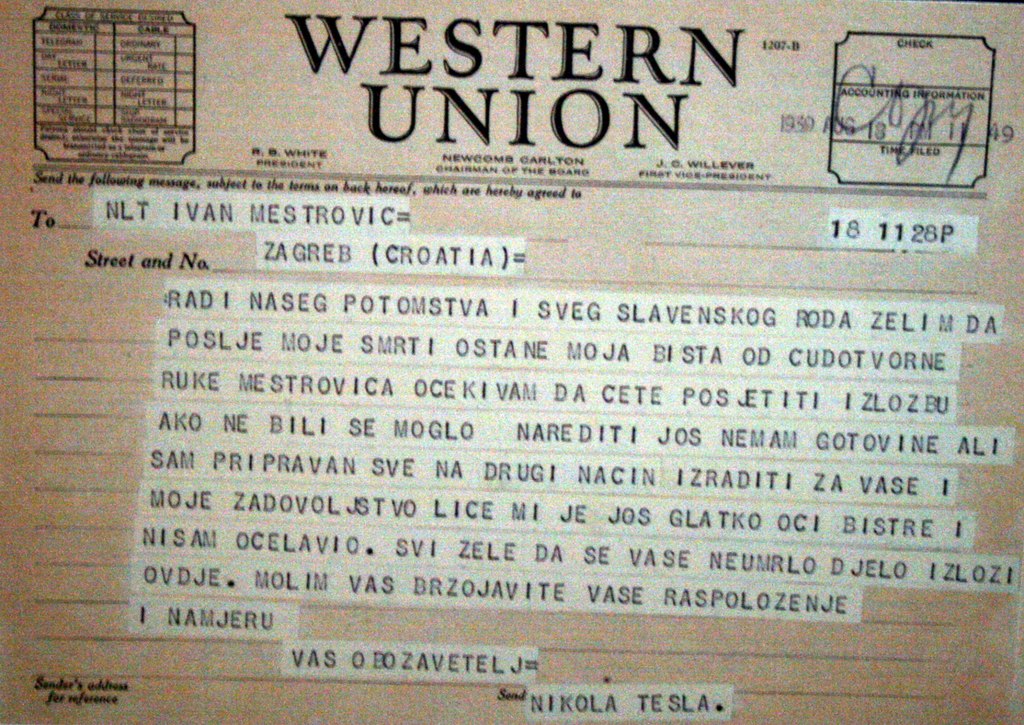Slavonia 365: Meet Zoran Simunovic, Osijek Artist of International Fame
January 10, 2023 - His career took off on the international scene, and he started producing artsy rugs to encourage local production in Vukovar. Zoran Simunovic is an up-and-coming artist from Osijek, a curator of the Vukovar Municipal Museum, and an all-round awesome tattooed human.
As Vecernji writes, those who appreciate the painting of gestural abstraction of high modernism of European provenance and the works of Pierre Soulages, Hans Hartung, or Edo Murtić will recognise, said Branko Franceschi at one time, the basic performance principles that build the solid core of the composition of the painter Zoran Simunovic. The derived characters were inspired by real life and create spaces of memory and nostalgia based on the transparent display of recognisable objects, almost fetishes, such as motifs of toys: teddy bears, trains, or bananas that his son Oskar loves. Every corner of his work of art is personalised and bears a mark that conveys memories and passion for home. Seemingly unimportant figurines, plants, and fruits become important because they are recorded on the canvases as artifacts of his becoming. They seem to almost float in the composition, concentrating in the centre of the painting, letting the colours completely occupy the edges of the canvas. His paintings, thus, halfway between figuration and abstraction, take on a strong narrative character and tell stories with a small dose of humour and a lot of poetry.

"My home is full of details. In essence, the observer is directly involved in the creation of the work through fragments of their growing up and their most beautiful memories, precisely their childhood. It is sometimes difficult for artists to expose their intimacy and show it to the world, but I have no problem with that", said the artist himself, who is well known on the local cultural scene. A native of Osijek, curator of the Vukovar Municipal Museum, and a true Slavonian addicted to tattoos. An eternal optimist who, as he says himself, does not see the world through rose-tinted glasses but through rose-tinted eyes. This can be seen in his paintings and the optimism they radiate, and there are currently additional reasons for a rosy mood, as his career has been on an upward international trajectory for some time, and his paintings have just been exhibited in the Vienna gallery District 4 Art.
"District 4 Art is one of the foreign galleries representing me as an author, and as part of its activities, it also prepares exhibitions. Negotiations with them began at the suggestion of my friend, collector Milan Krivda, and after a quick agreement, they resulted in successful and pleasant cooperation. Basically, many people are interested in my works, among them are some celebrities, but discretion is highly valued in this business, so I would rather not go into details", Zoran Simunovic answered somewhat self-deprecatingly when asked about stars from the world of art who became interested in his playful oils on canvas, primarily in large formats, which fetch up to 20,000 euros on the European market.
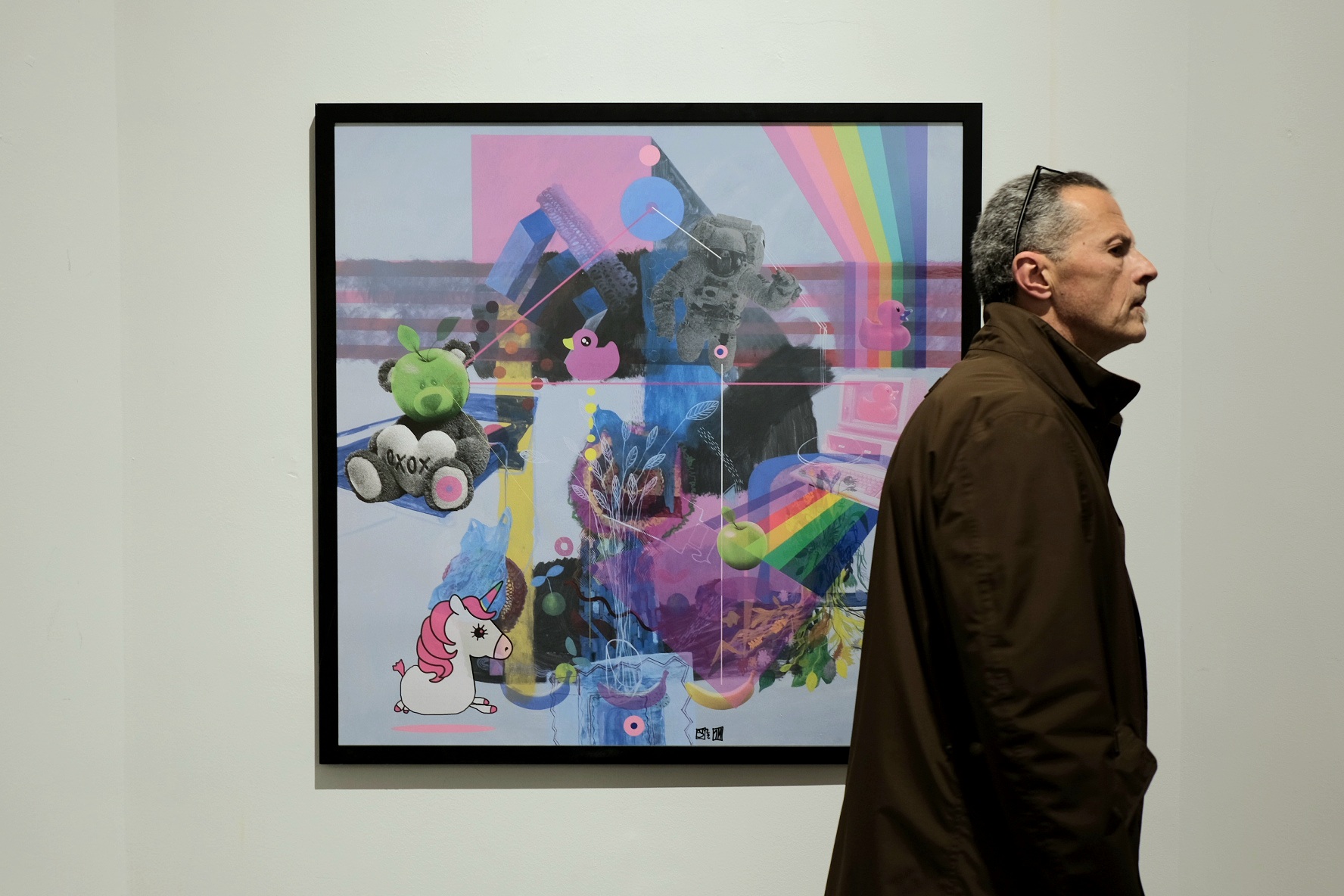
What is the profile of the people who are the majority of Zoran's customers? "Their profile is quite diverse. Moreover, today it is extremely difficult to assess who a potential customer is. You'd have clients who simply want to treat themselves to one of my works, while on the other hand, there are clients who are serious collectors and invest in the future. What pleases me the most is that all my clients, regardless of which group they come from, buy my paintings primarily because they enjoy them. In this context, I have to be proud that all my paintings they bought are on their walls and exposed to the view, and not waiting in some dark warehouse for a higher market price", says the artist.
He also exhibited a novelty in Vienna - the rugs he makes in Vukovar, and on which he copies the motifs of his paintings. It turned out to be an excellent decision, he says, because the reactions were more than positive. The story of his breakthrough into art is well known, but since repetition is the mother of wisdom: He was born in 1984 in Nuštar as the son of a farmer and grew up on a large farm where wheat, barley, corn, and rapeseed are grown. He spent his childhood, he recalls, in a tractor and forklift, helping his family in the fields. His parents wanted him to run the family business, so he enrolled at the Faculty of Agriculture, but he soon realised it was not the right path for him and left it after only one year. His wife Ivana played a key role, and after seeing some of his drawings, she persuaded him to enroll in the Academy of Fine Arts. That decision changed his life forever; he discovered his passion for art and creation, which he says is his greatest blessing.
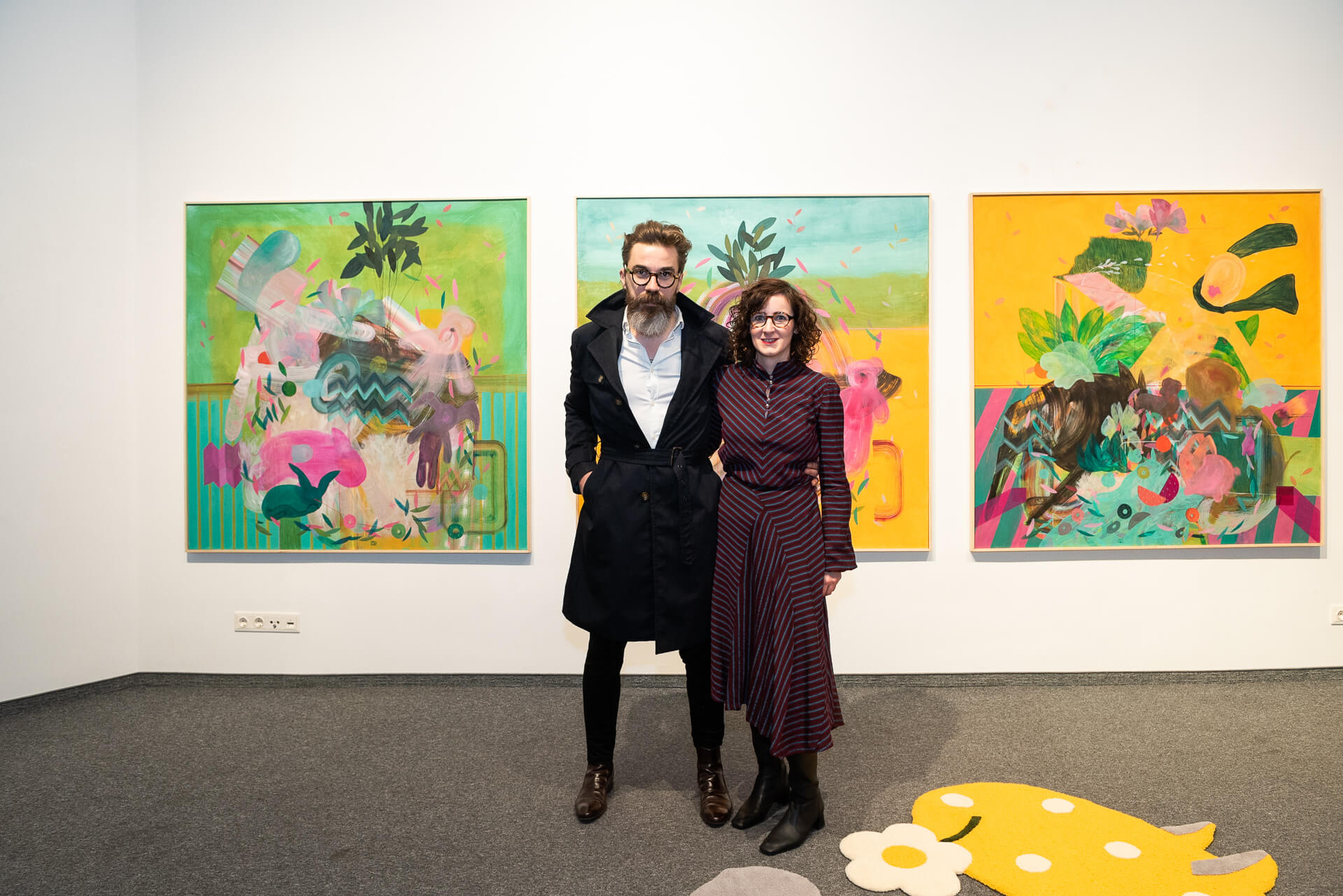
In 2008, he enrolled in the Academy of Fine Arts in Široki Brijeg, graduated in 2013 in the class of Professor Antun Boris Svaljek, and then got a job as a curator at the Vukovar Municipal Museum, where he develops a playful cultural program aimed at a younger audience. "My job as curator of the Vukovar museum is the best job in the world. I cooperate with many artists, institutions, museums, and embassies, which helped me a lot and influenced the development of my artistic career. The artist and the museum need each other, and I achieved a perfect synthesis of both. I try to work professionally in both fields; both of my jobs are extremely creative; they connect and complement each other perfectly", says Zoran Simunovic.
In private life, he defines himself as a hedonist – he loves beautiful things and lives life with pleasure. He pays special attention to his image, it is part of the whole package, and he has a special passion for tattoos. His body is an extension of the painter's canvas, he tattoos himself, and each tattoo is a piece in the creation of a unique work, a project that, he says, will never be finished and will grow with him.

As for Osijek's art scene, he is satisfied and does not complain about Zagreb's centralisation, which many point out as a problem. "There are different profiles of artists as well as their art worlds. I believe that every region offers several good authors, including the east of Croatia. Osijek, as the centre of Slavonia and Baranja, offers both authors and audiences a wide choice. I am convinced that there is enough space for all high-quality artists from all artistic fields to find their place under the sun, wherever it may be", he said. Asked about a potential business offer that might one day prompt him to move from Slavonia, he continued: "I love Slavonia. It is my home. As a city, Osijek offers absolutely everything you need for a pleasant and quality life. Never say never, though. For now, I have no intention of leaving my home, but life may have other plans for me.
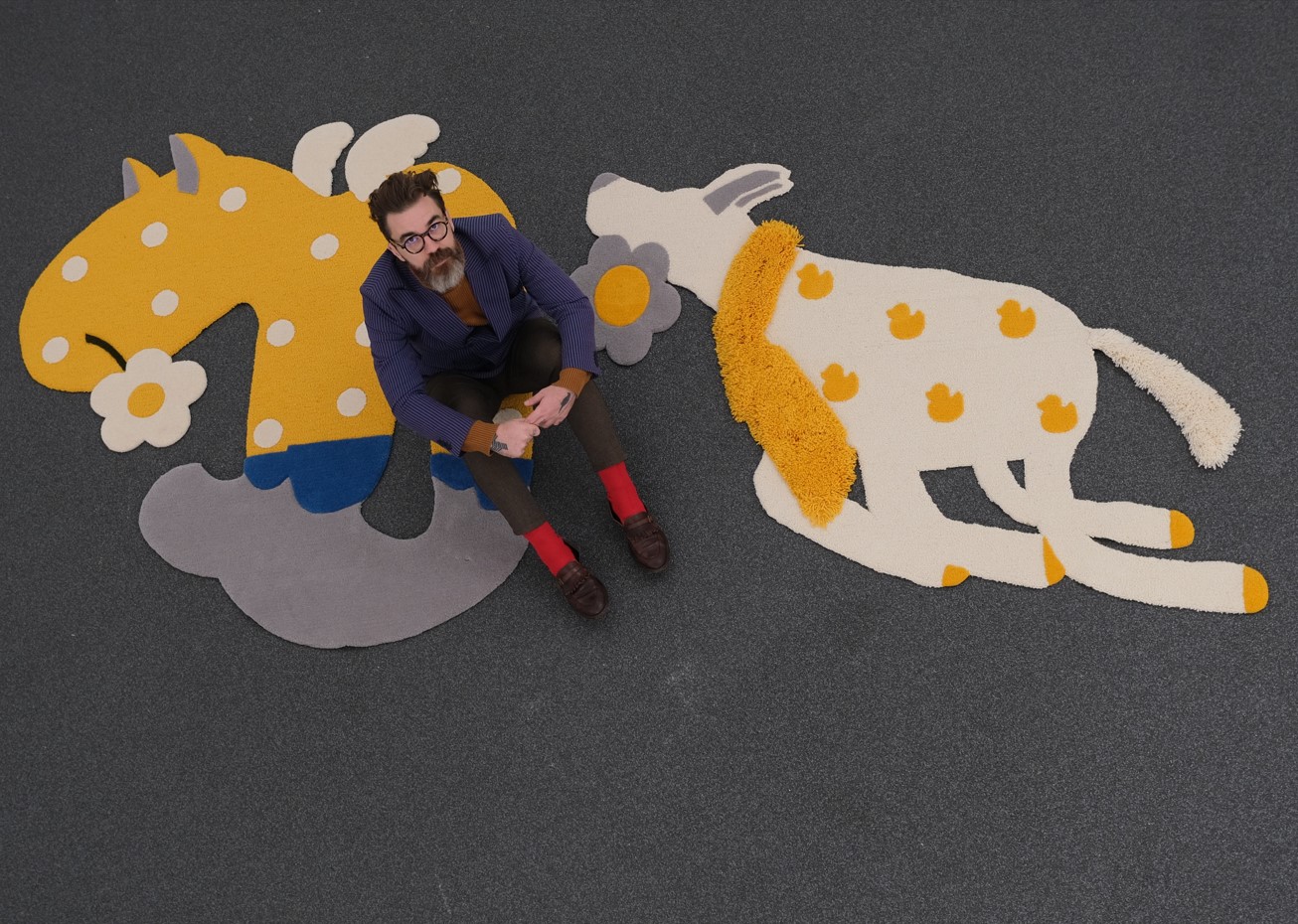
Rugs have become an extension of his painting canvas. The quirky design of rugs with a crazy character is an absolute trend in interior design. Zoran Simunovic recognised this and translated his pictures into unique artsy rugs. "The rugs are something new that I made. After ten years of activity, I felt the need to express myself artistically in a different way. Rugs are perfect for me because it is widely known that I am a big fan of product design and that, among other things, I show interiors in my paintings. So I transferred my paintings to a piece of furniture because these rugs are segments of my paintings. Also, it was important to me that all production work be carried out at the local level to encourage each other to grow. I was also very surprised when I discovered that in Vukovar, it was possible to make a personalised carpet from high-quality wool that meets all aesthetic and quality standards", said Simunovic.
For more, make sure to check out our dedicated Lifestyle section.
Maksimilijan Vanka Gallery to Reopen in the Artist's Villa in Korčula
March 14th, 2022 - The entire Memorial Collection of Maksimilijan Vanka will be restored and moved from Zagreb back into its home on Korčula
As announced by Korčula Mayor Nika Silić Maroević, the lovely villa in Korčula town that was once owned by Croatian artist Maksimilijan Vanka is finally to be restored.
In 1935, Vanka moved to the US where he's best remembered for painting the Millvale Murals in the St. Nicholas Croatian Catholic Church. The renowned painter and sculptor used to spend summers on Korčula island, where he founded an art colony and socialised with his fellow artists.
His former holiday home is known as one of the most beautiful villas in town, located near the monastery of St. Nicholas, reports Dubrovački vjesnik.
After Vanka’s death in 1963, his widow Margaret Stetten Vanka and daughter Peggy Vanka Brasko donated two houses in Korčula to the Croatian Academy of Sciences and Arts (HAZU), along with 47 of Vanka’s artworks created in Korčula and the US.
The other, smaller villa donated to the HAZU by the Vanka family had a different fate. In the early 90s, it was transferred into private ownership and has been sold since.
The bigger villa, now to be restored, used to house the Memorial Collection of Maksimilijan Vanka. Due to poor conditions in the villa, the art collection was moved to Zagreb and is currently kept at the Strossmayer Gallery of Old Masters.
Two years ago, it was announced that the entire collection will be restored, with funds secured by the Society of Maksilimijan Vanka’s Friends from the US. Once the restoration is completed, the artworks should be moved back to Korčula, but it’s not yet known when this is supposed to take place.
Renovation of the villa should have started two years ago when the president of the Croatian Academy of Sciences and Arts (HAZU) signed a cooperation agreement with the then Mayor of Korčula, providing for the renovation, reconstruction and adaptation of Villa Vanka and the restoration and return of Vanka's art collection to Korčula.
Unfortunately, the global pandemic began shortly after the agreement was signed, so the plans had to be put on hold for a while.
‘In the meantime, potential investors expressed certain interests that the HAZU approved as well, so we will amend the existing agreement a bit in order to further define certain details’, announced Mayor Silić Maroević.
Amendments to the agreement mainly relate to the catering business conducted in the villa, which proved not to be a good decision in the past, according to the mayor. Ten years ago, the gallery was renovated, but not in a dignified manner, she pointed out, and part of the gallery was leased by a catering business, which isn’t acceptable to the City of Korčula or the HAZU.
Villa Vanka will now be renovated and used exclusively as a gallery, the only exception being the lower part of the warehouse which might eventually be leased out for service activities. This will be defined by the new agreement, said Mayor Silić Maroević.
Although Korčula boasts incredible cultural heritage and numerous acclaimed artists, the town sorely lacks gallery spaces. This is yet another reason why everyone’s looking forward to the renovation of Villa Vanka, with the new gallery seen as a crucial venue for the cultural life in Korčula.
‘Your Fan, Nikola Tesla’: When the Great Inventor Met Ivan Meštrović
January 16th 2022 - Ivan Meštrović, a master sculptor and one of the most renowned Croatian artists of all time, died on this day in 1962. A lesser known fact about Meštrović is that he was friends with another famous figure from these parts, the great inventor Nikola Tesla. The two great men met in New York and maintained a decades-long friendship through correspondence
Ivan Meštrović, a master sculptor and one of the most renowned Croatian artists of all time, died on this day in 1962. Having gained United States citizenship a few years earlier, Meštrović passed away in the US, after an illustrious international career and numerous accolades won for his exceptional artistic work.
He was one of the rare Croatian artists to gain international recognition during his lifetime: he lived, worked, taught, and exhibited his art in Split, Paris, Rome, Belgrade, Zagreb, London, Geneva, Cannes, and all over the US. He was the first living artist to get a solo exhibition at the Metropolitan Museum in New York (1947).
Meštrović was the genius mind behind some of the most recognisable landmarks and monuments in Croatia. The Well of Life was installed in front of the Croatian National Theatre in Zagreb in 1912:
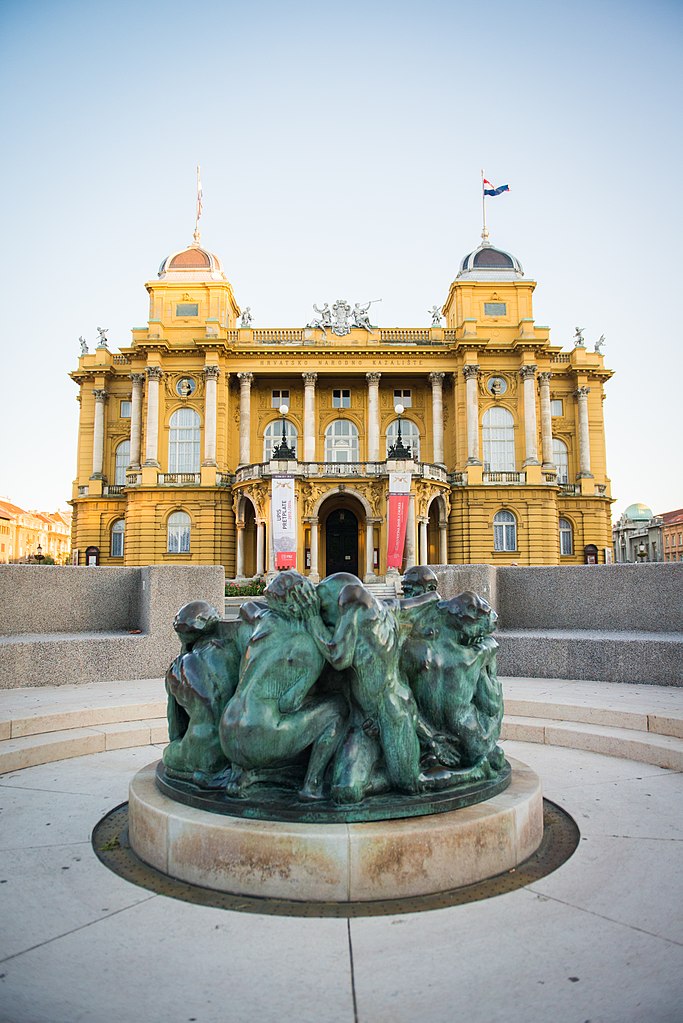
Another iconic landmark in Zagreb, the Home of Croatian Artists also known as Džamija (The Mosque), was designed by Meštrović and completed in 1938 - hence its other nickname, the Meštrović pavilion:
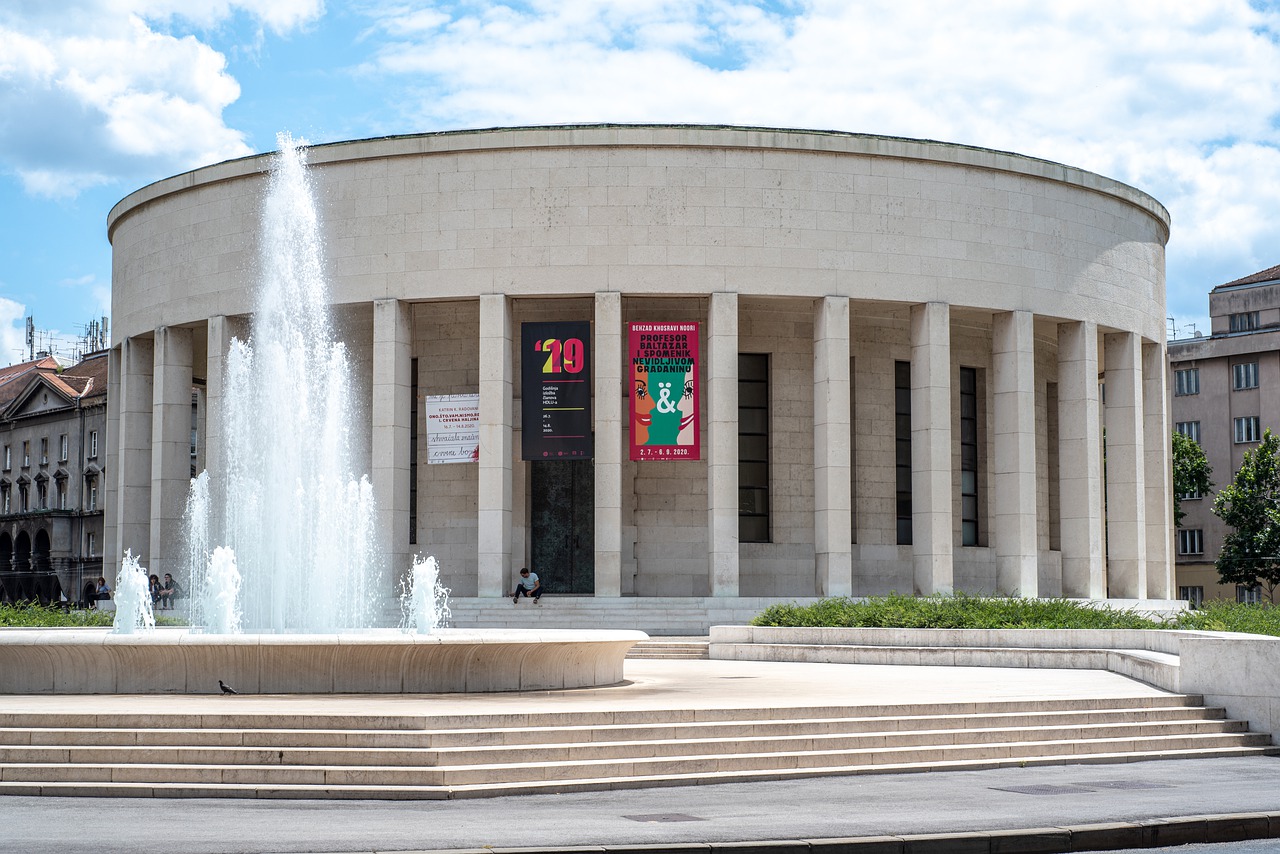
The gigantic statue of Gregory of Nin (Grgur Ninski) was initially installed at the Peristil in Split and later moved to its present location in front of the Golden Gate, where tourists in passing rub the saint’s big toe for luck.

Photo: Statue of Gregorius of Nin in Split, Croatia by Marco Verch under Creative Commons 2.0
A lesser known fact about the master artist is that he was friends with another famous figure from these parts - the great inventor and scientist Nikola Tesla.
Tesla and Meštrović met in New York in 1924, where Meštrović had a solo exhibition at the Brooklyn Museum. Knowing that Tesla was also residing in New York at the time, the artist reached out with a letter expressing his wish to meet, sent from Hotel Gotham on December 13th:
Dear Mr Tesla, one of my main wishes in coming here was to meet you, wrote Meštrović.
Tesla wrote back from Hotel Marguery two days later:
Dear and great artist! I was happy to receive your letter and will be even more glad to meet you in person, as this has been a fervent wish of mine for many years now, replied Tesla with enthusiasm and proposed a meetup time. This was the beginning of a long friendship between the two men, each a master in his own field.
***
In the years that followed, Tesla saw other exhibitions of Meštrović’s work in the US, and wrote to the artist to express his admiration after an exhibition in Chicago in 1929.
They exchanged Christmas cards as well; they are kept at the Nikola Tesla Museum in Belgrade together with the letters and telegrams.
Another touching letter dates to November 12th, 1929 when Meštrović acted as a middleman for Matica srpska, a distinguished Serbian cultural-scientific institution that wanted to publish a biography of the great inventor.
I don’t know why they chose to go through me: either you weren’t replying to them, or they think you and I are closely acquainted making this a more convenient way [to reach you]. I would ask you to accommodate their request, not for their sake or mine, but for the sake of our nation, and most of all for the sake of younger generations who will see in you the most wonderful example of intellectual and moral virtue, urged Meštrović, going on to suggest that Tesla set a condition for his autobiography to be published in both the Latin and Cyrillic script.
***
In a telegram sent in 1939 Nikola Tesla expressed his wish for Meštrović to sculpt a bust of him.
Artists were known to frequently approach Tesla to ask if he would sit for a portrait, and he turned them all down - save for princess Vilma Lwoff-Parlaghy whose drawing was unfortunately lost. That he would personally reach out to Meštrović to commission a portrait bust only speaks to his respect for the master artist.
This is the telegram:
Sent from NYC to Zagreb on August 18th, 1939
The message reads,
For the sake of our descendants and all Slavic people I wish for a bust of me, made by the miraculous hand of Meštrović, to remain after my death. I don’t yet have cash, but I am willing to do everything to your satisfaction and mine by other means. My face is still smooth, my eyes bright, and I haven’t gone bald. Everyone wishes for your immortal work to be displayed here. Please send a telegram to state your opinion and intent. Your fan, Nikola Tesla.
Imagine having Nikola Tesla for a fan.
Meštrović promptly wrote back from Split:
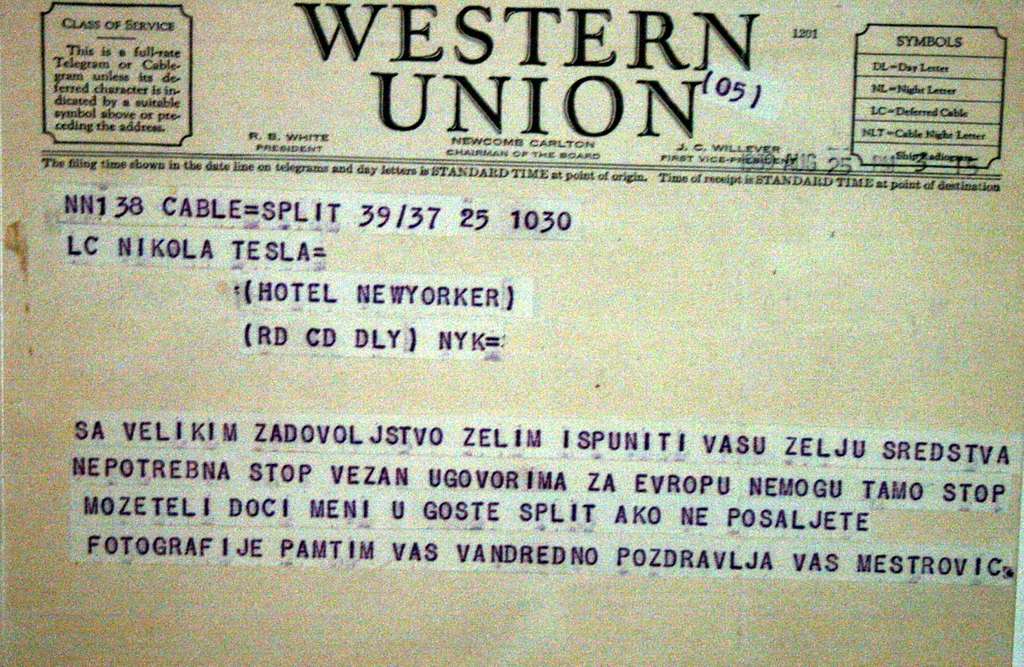
Sent from Split to NYC on August 25th, 1939
The telegram sent to Tesla reads,
It would be my great pleasure to fulfil your wish. Funds not necessary. I am bound by contracts in Europe, I can’t go there [USA]. Can you be my guest in Split, if you can’t, send some photos, I remember you vividly. Greetings from Meštrović.
Tesla was 83 years old at the time and was unable to travel that far, so he didn’t get a chance to pose for Meštrović before he died. The master sculptor kept his word regardless, creating two sculptures of Nikola Tesla in the years that followed.
One is a bronze bust whose original plaster model is displayed at the Croatian Academy of Sciences and Arts in Zagreb; bronze replicas are on display at the Nikola Tesla Museum in Belgrade and the Technical Museum in Vienna.
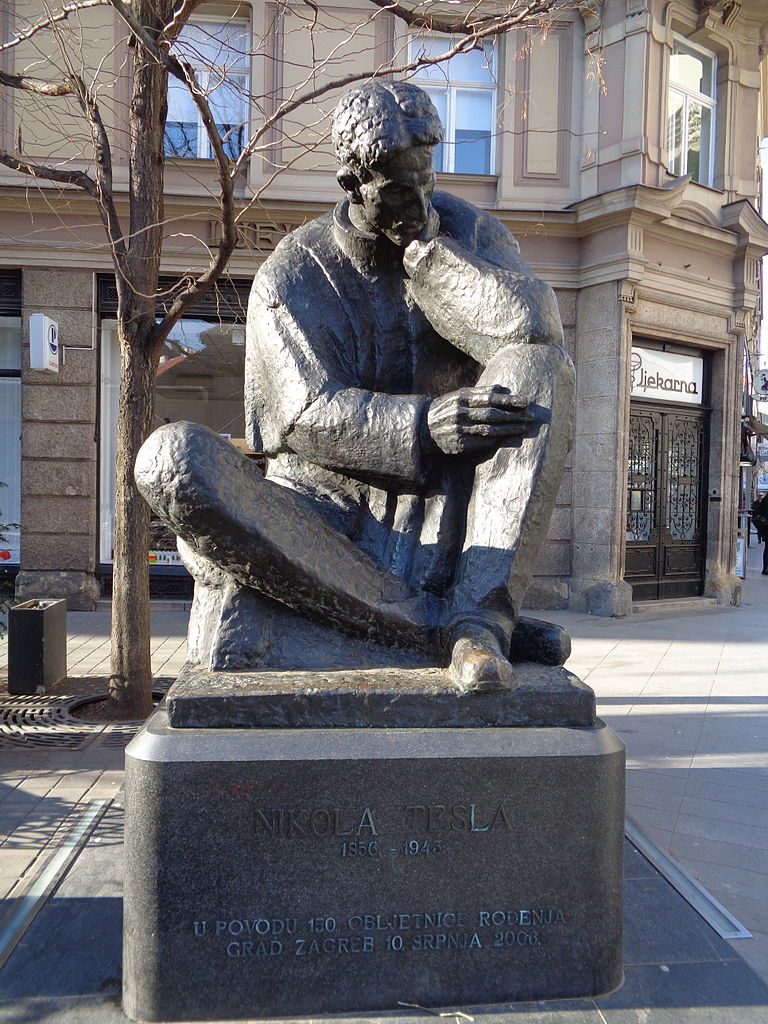
The other is the grand monument of Tesla displayed in Zagreb, shown on the photo above. It was originally installed in front of the Ruđer Bošković Institute in 1956, after Meštrović personally reached out to Croatian physicist Ivan Supek, the founder of the RB Institute. Supek recalled his correspondence with the artist for Jutarnji list/Tanja Rudež.
Meštrović was teaching at the University of Notre Dame in the US at the time, but kept close ties with his homeland. After an earlier sculpture of his, that of Croatian scientist Ruđer Bošković was installed in front of the Institute, he wrote to Supek saying he considered Tesla one of the greatest men from these parts. He said that he would gladly build Tesla a monument and asked for Supek’s opinion - naturally, he agreed, and the work was thus completed and displayed at the institute a year later.
In 2006, the monument was moved to its present location in the city centre, in the street named after Nikola Tesla.
To learn more about Ivan Meštrović and his legacy, visit the pages of Ivan Meštrović Museums / Muzeji Ivana Meštrovića.
PHOTOS: Huge New Street Art by Zagreb's Lunar in Rijeka and Dobrinj
December 2, 2020 – Streets have been noticeably quieter over recent days, although not by one building in Rijeka and a roadside in Dobrinj, Krk island, where renowned street artist, Zagreb's Lunar, has left two huge new murals
The cafes are closed but, what's more, there's a chill in the air. It's not only the lockdown that has made the streets of Croatia more quiet than usual at this time of year. Over recent days, temperatures have dropped to around zero when the sun falls. And it falls early. The light can be gone by 5pm. Rijeka
Rijeka
Exercise or a simple pleasant stroll around the Christmas lights have been all that's been drawing folks out onto the streets after dark, save for the food delivery guys whose bikes whizz past you faster than ever in the chill. Even during the day, the streets of Croatia are quieter than normal because of the lockdown.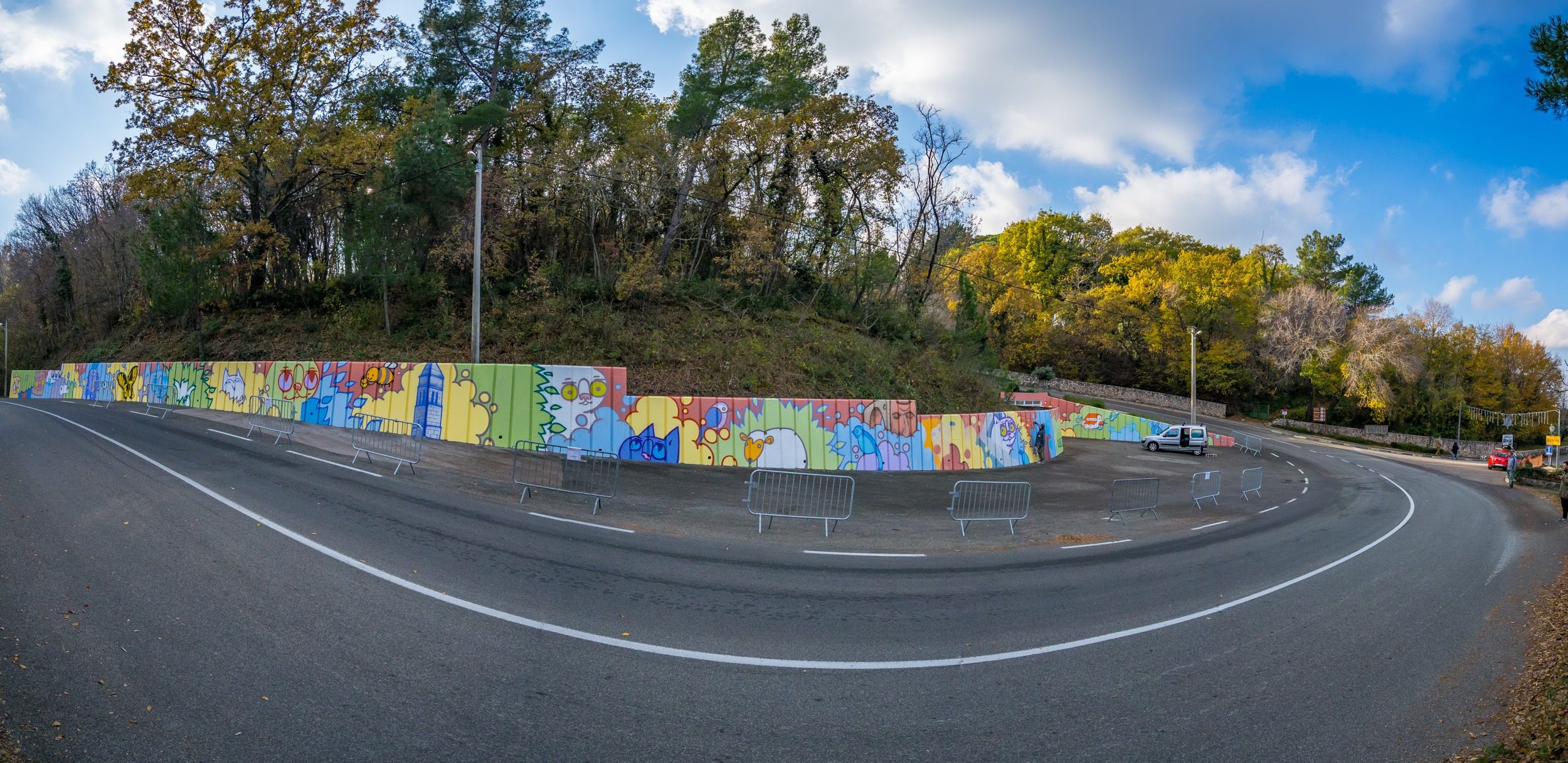
Dobrinj
But, these days haven't been anything other than normal for acclaimed artist Slaven Kosanovic aka Zagreb's Lunar. The cooler temperatures have only meant wearing more clothes and the quieter streets have not made his careful craftsmanship any quicker. His sometimes vast murals often require him to be above pedestrians passing below, up a ladder or even on a crane.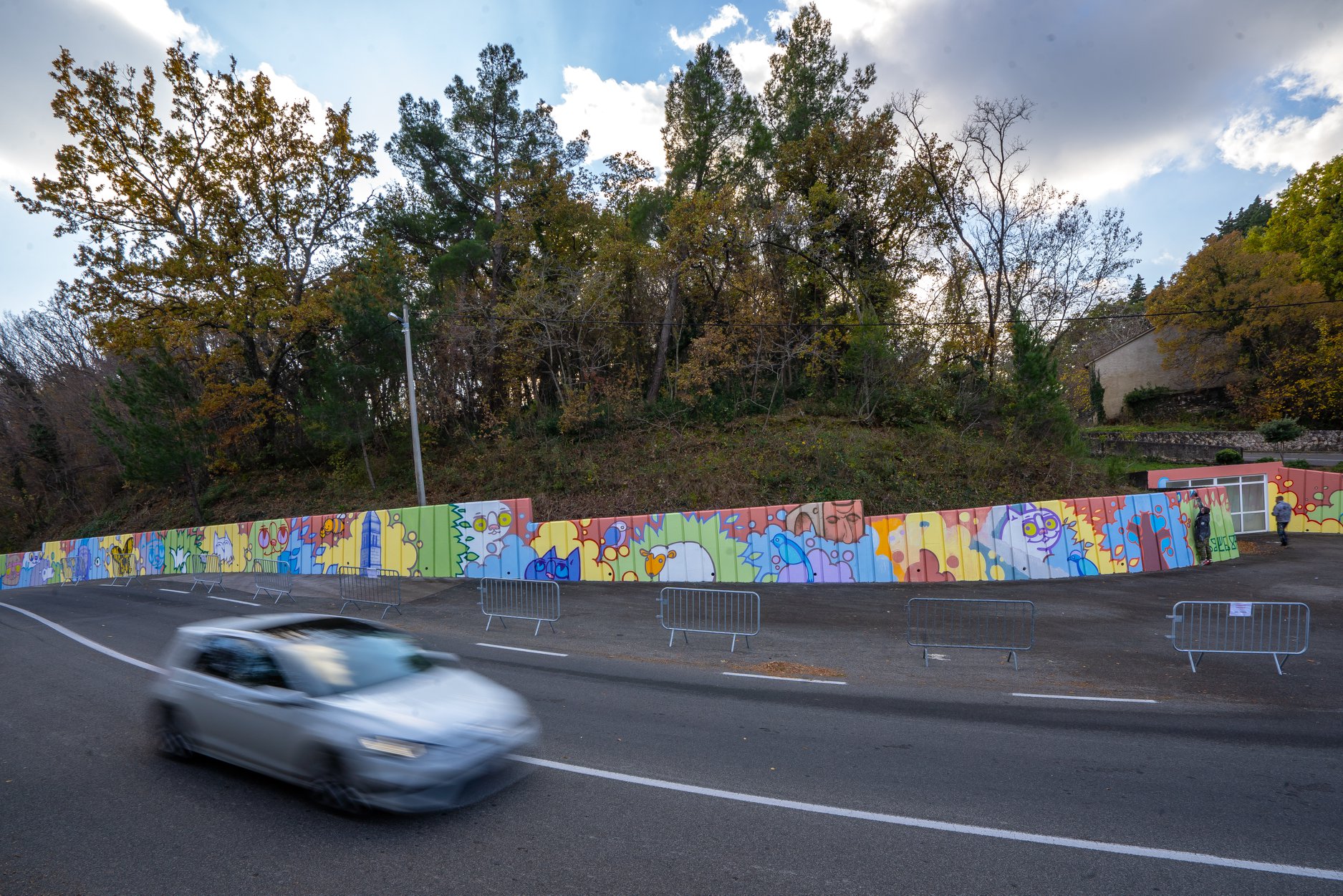 Dobrinj
Dobrinj
The two new paintings of Zagreb's Lunar definitely fall at the larger end of the works he has produced over the last 25+ years. One towers above street level on an entire building facade in Rijeka. So tall is the painting that trying to take it all in could strain your neck in the wrong wind. The other piece, in Dobrinj, Krk island, is just as epic, although this vast canvas lies horizontal, by the roadside.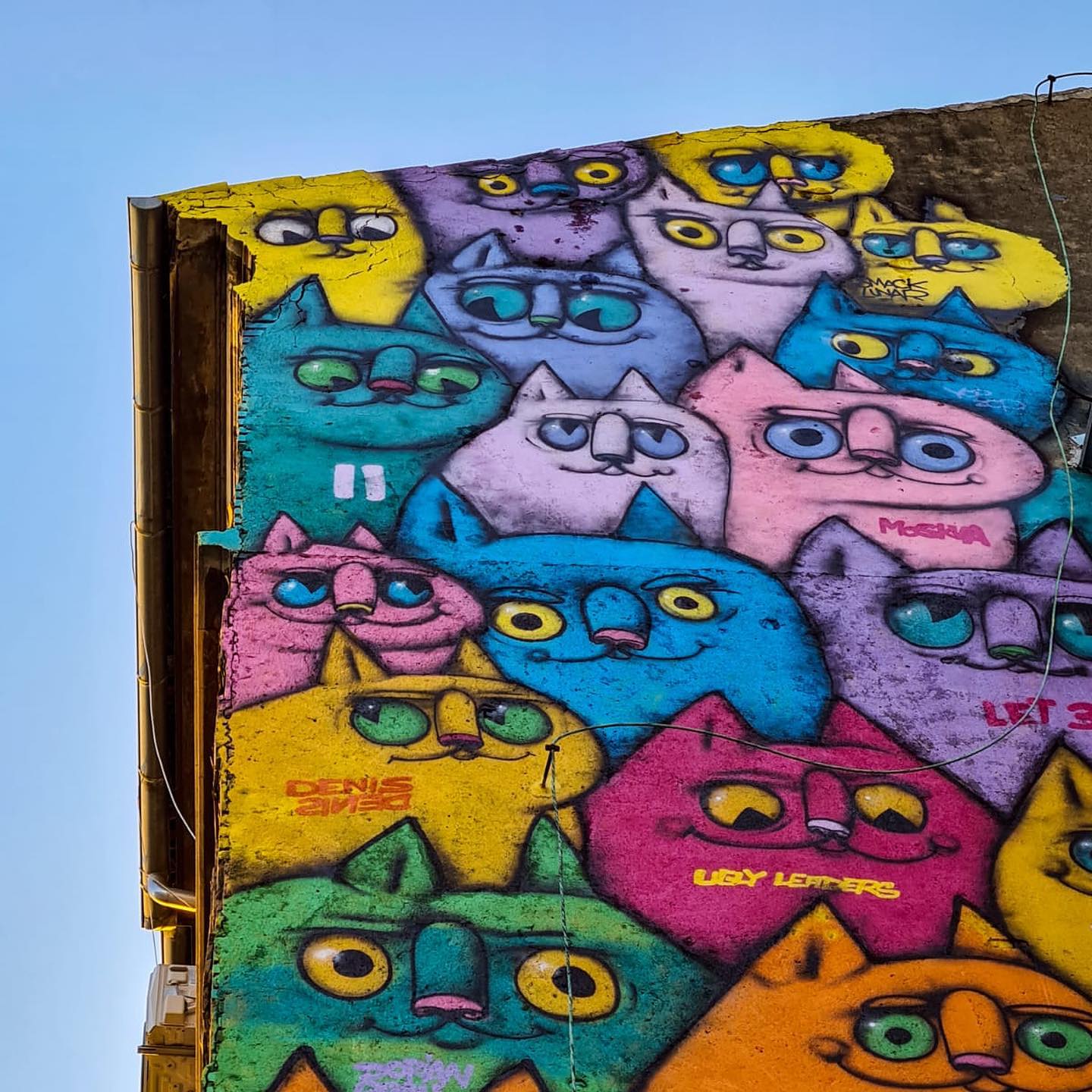 The Rijeka mural is dedicated to the city's music scene - you can spot some of the names of famous Rijeka bands in the painting
The Rijeka mural is dedicated to the city's music scene - you can spot some of the names of famous Rijeka bands in the painting
The Rijeka mural of Zagreb's Lunar, which he painted alongside his brother, with whom he often collaborates, is a four-story wall of cats dedicated to Rijeka's famous music scene. The mural took two days to complete. In the mural, you can spot the names of many Rijeka music groups like The Siids. Let 3, Denis & Denis and Jonathan. The mural is another part of the manifestations organised in celebration of Rijeka 2020 Capital of Culture.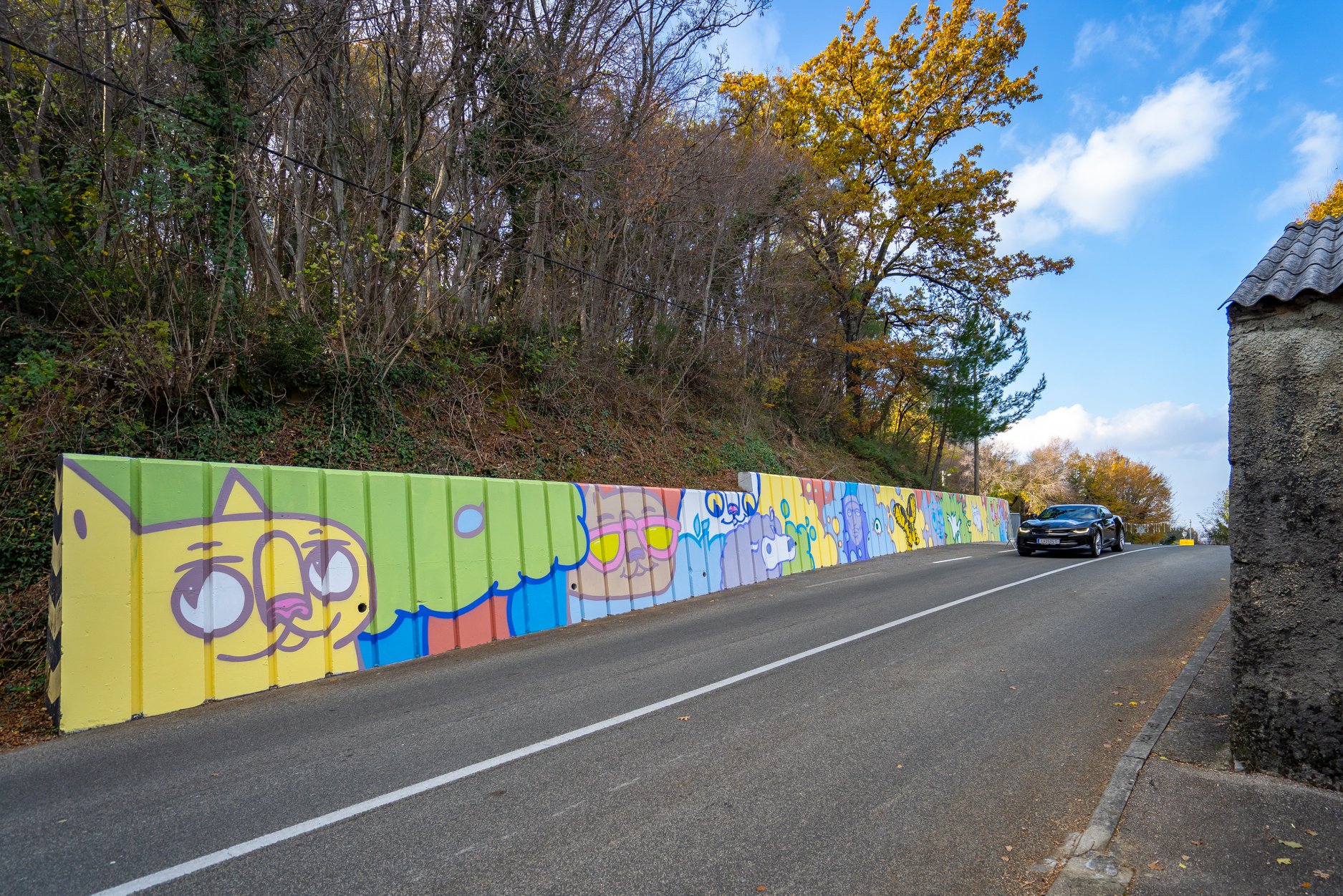 Dobrinj
Dobrinj
Krk island is a well-known tourist destination, but the pretty inland village of Dobrinj is far from the regular path of visitors. Anyone travelling past the enormous mural Zagreb's Lunar and his brother have left here will surely remember the name of Dobrinj. It may well entice some to come looking for it – it is by far the largest piece of public art on the island. It was facilitated by the community organisation Kulturni Dobrinj.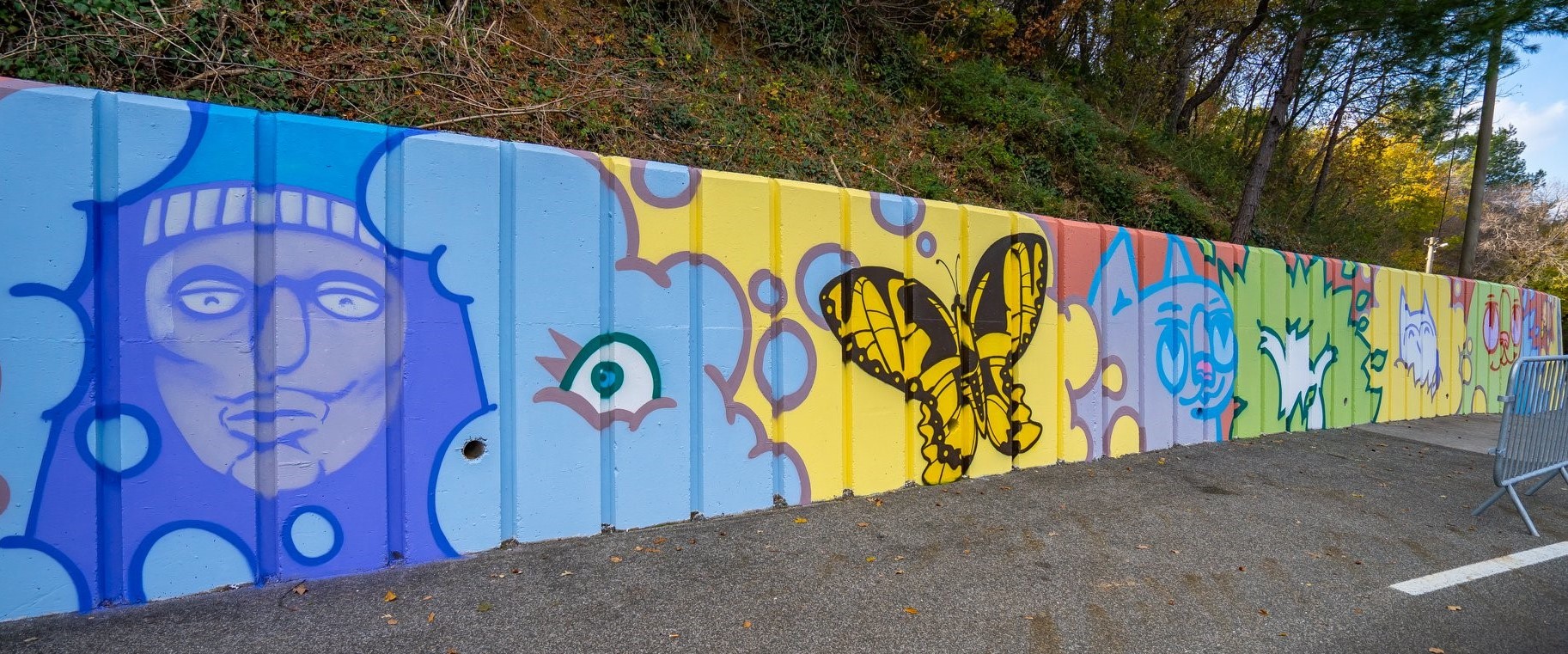 Dobrinj
Dobrinj
All photos © Antonija Diklic (Rijeka) Damir Jevtic (Dobrinj)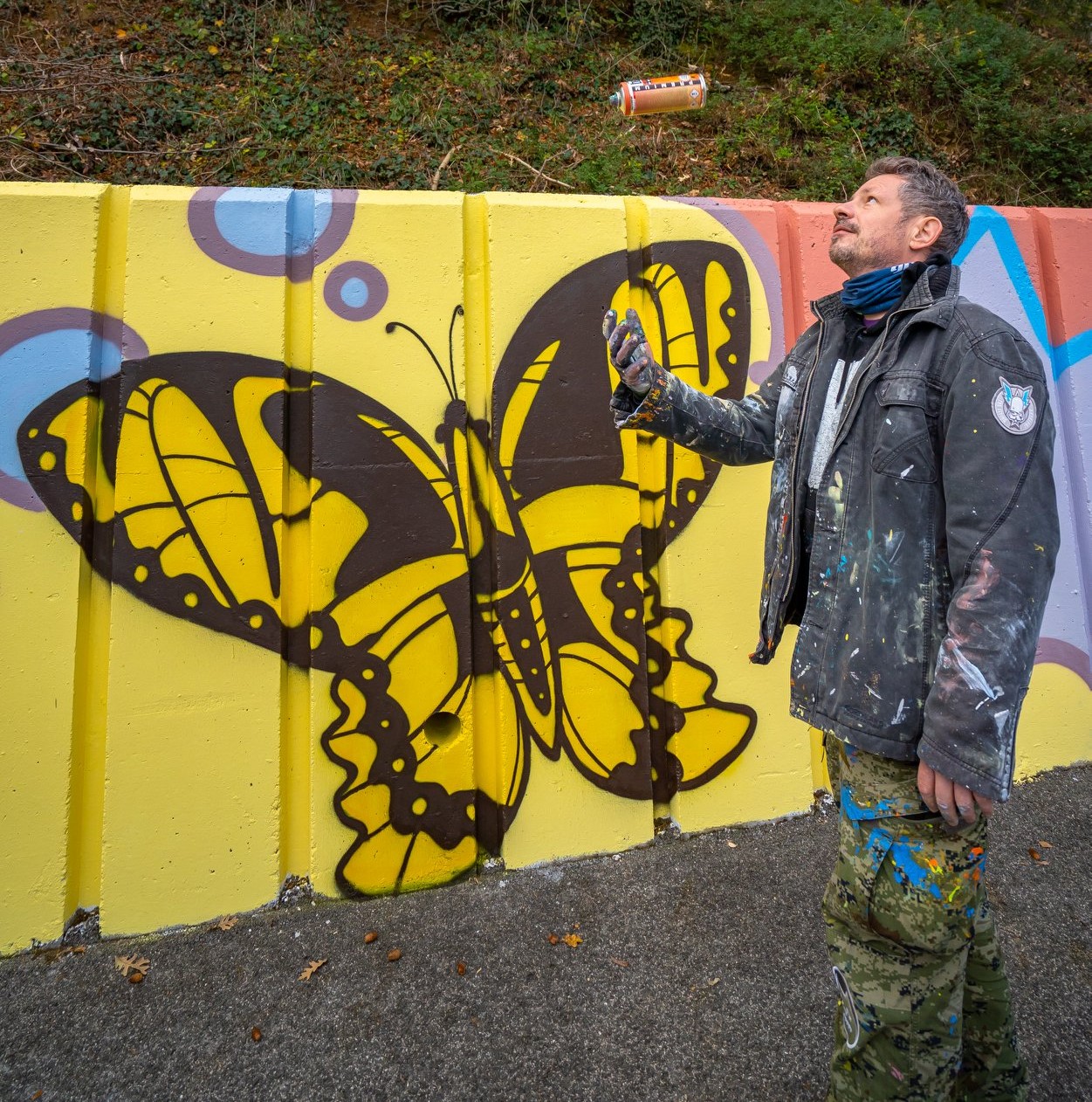 Dobrinj, with the artist, Slaven Kosanovic aka Zagreb's Lunar, on the right
Dobrinj, with the artist, Slaven Kosanovic aka Zagreb's Lunar, on the right
Exhibition about Croatian Architect Vjenceslav Richter to Open in Belgium
ZAGREB, March 2, 2020 - "The World as a Pavilion. Vjenceslav Richter" exhibition, dedicated to the Croatian architect and artist established also on the European scene, opens on 4 March at the Centre for Fine Arts Bozar in Brussels on the occasion of the Croatian Presidency of the Council of the EU.
Organised in cooperation between the Zagreb Museum of Contemporary Art (MSU) and the Brussels Centre for Fine Arts Bozar, the exhibition contains around one hundred of Richter's works, with synthesis as the starting point of his work in architecture, art, theory and experimentation.
The art piece "Man standing in a museum looking at something" (2017) by Marko Tadic will also be included in the exhibition.
Richter was one of the central figures of the Croatian art scene in the second half of the 20th century, and he left an important mark in the European art history as well. He was one of the founders of the EXAT-51 art group, an active participant in the New Tendencies) exhibitions, he designed many residential and public buildings, and authored several conceptual designs in urban planning.
The exhibition will be on view until 19 Apri.
A series of Croatian cultural programmes in March across Europe
As part of the Croatian presidency of the EU cultural programme, an intensive presentation of Croatian culture and heritage continues in March, starting with screenings of Vlado Kristl's films on 2 March at the Goethe Institute in Paris.
Among larger exhibitions, three stand out: the Miroslav Kraljević exhibition opening on 3 March in Budapest, the exhibition of posters by Boris Bućan opening in Krakow on 31 March, and the Lumbarda Psephisma exhibition at the National Archaeological Museum of Greece in Athens.
As for theatre, two plays will be performed on 11 March in Brussels: "Staging a play. Tartuffe" by Matija Ferlin and "Love will tear us apart", a dance play by the theatrical troupe De Facto.
The orchestra of the Lado national folk-dance ensemble will give a concert in Sofia on 19 March, and the "Three Winters" play from the Croatian National Theatre in Zagreb will be performed on 21 March in Brussels.
Croatian writers will present their work at book fairs in Leipzig (12-15 March) and Paris (20-23 March).
More culture news can be found in the Lifestyle section.
HDLU Launches New Art Project in Prisons
ZAGREB, February 17, 2020 - After successfully implementing the projects "Exemplary Penitentiary" at the Požega Penitentiary and "Art Revitalisation of the Prison Space" at the Zagreb Prison, the Croatian Association of Artists (HDLU) has announced the start of the project "The Horizon of Freedom" at the Glina Penitentiary and the Zagreb Prison Hospital.
At the Glina Penitentiary the prisoners and artists will paint a joint mural, and there will also be art workshops for prisoners. Two art interventions are planned for the Zagreb Prison Hospital as well.
Previous projects have shown that art has a truly transformative power. It contributes to creating a new, more humane, supporting and nurturing environment, it creates conditions for developing awareness, responsibility and empathy in prisoners, and it helps them to develop skills and live a more meaningful and productive life, the HDLU reports.
The project "The Horizon of Freedom" has a similar aim - to continue with the artistic and therapeutic practice of intervention within the Croatian prison system, with emphasis on the aestheticization of the prisoners' living space and the work space of prison officers, as well as on involving prisoners in the creative process and discussions about art, changes in space and in the individual inhabiting that space.
The project "The Horizon of Freedom" by Melinda Šefčić was selected through a public tender by the Ministry of Justice and will be financed with 200,000 kuna. The accompanying research will be done by Anita Jandrić Nišević and Melinda Šefčić.
More art news can be found in the Lifestyle section.
Poland Awards State Decoration to Rumjana and Mate Meštrović
ZAGREB, September 20, 2019 - The Commander's Cross of the Order of Merit of the Republic of Poland was presented to Rumjana and Mate Meštrović, heirs to Croatian sculptor Ivan Meštrović, at a ceremony at the Polish Embassy in Zagreb on Thursday.
Rumjana and Mate Meštrović received the high state decoration for their long-standing cooperation with Poland, which last year was crowned with their donation of a bust of Polish statesman Jozef Pilsudski, a work by sculptor Ivan Meštrović.
Meštrović made a 25-metre statue of Pilsudski, Poland's prime minister from 1926 to 1935, but he never finished his work due to the start of World War II.
Polish Ambassador Andrzej Jasionowski commended at today's ceremony the initiative of the Mestrovic family, who as heirs to the bequest of the world-famous sculptor donated the Polish people his work of art, thus contributing to the cooperation between Poland and Croatia.
The Pilsudski bust was made in 1939 and was to have been erected together with the rest of the monument in Warsaw.
The donated bust of Jozef Pilsudski is now located in the lobby of the Polish Embassy in Zagreb.
More news about relations between Croatia and Poland can be found in the Politics section.
Russian Art Collection in Zagreb: Putin to Seek Paintings Worth Millions?
Russian diplomats in Zagreb are preparing for the first official visit of Russian President Vladimir Putin to Croatia, which could be organised next year. Putin and Croatian officials would undoubtedly have a number of important topics to discuss: gasification, Agrokor, Russian investments in Croatian companies, hotels, trade exchange, Ukrainian issue etc. But, according to the latest edition of the Express magazine, the question of paintings by Russian artist Nicholas Roerich (born as Nikolai Konstantinovich Rerikh) could also be in focus, reports 24sata.hr on May 17, 2019.
The issue includes the possible return of ten of his valuable paintings that have been held by the Modern Gallery in Zagreb for more than 85 years. Russian Ambassador Azimov has opened the issue of giving these paintings to Russia, the country which Roerich left in 1917 and never came back. Although the paintings are well taken care of by the Modern Gallery, Ambassador Azimov said Russia would ask for them because there “would be more interest for them there.”
Before the return of the works, it is necessary to determine the ownership, which is why the Russian Embassy has opened talks with the Croatian Ministry of Culture. “We have held talks with representatives of the ministry and the museum. They are ready to discuss this issue constructively, but it also raises the question of whether there are any documents that the Russian side can present to prove its ownership of the paintings. We believe that the extensive correspondence between Roerich, his assistants and the Yugoslav Academy of Sciences from the early 1930s exists in the archives in Belgrade,” Azimov told the Russian news agency TASS.
The Culture Ministry also issued a statement. “The handover of paintings between the Yugoslav Academy of Sciences and Arts and the founder of the Modern Gallery, the Croatian Art Society “Strossmayer”, took place in 1934, and there is an official record. The paintings are protected cultural heritage which has been registered in the Register of Cultural Goods of the Republic of Croatia. According to the Law on Protection and Conservation of Cultural Goods, their permanent, unlimited removal from Croatia is not allowed,” said the ministry.
Igor Zidić, a renowned art historian and the director of the Modern Gallery from the late 1980s to 2008, agrees with the ministry. “Somebody is obviously questioning the ownership. If the paintings are registered in inventory books, then there can be no doubt. No institution in the country would decide to hand over the paintings. That is how it used to be 45 years ago. For example, Nikita Khrushchev came to Split and received one of Vidović’s oil paintings that was supposed to go to Vidović’s museum. This is no longer permissible,” said Zidić.
Roerich created more than 7,000 works during his career. His works reach a price of several hundred thousand dollars at auctions, while the famous painting “Madonna Laboris” was sold several years ago for nearly 70 million. The value of the collection at the Modern Gallery is estimated at millions of euros.
Translated from 24sata.hr (reported by Antonija Vrčić/Express).
More news about relations between Croatia and Russia can be found in the Politics section.
Croatia to Participate in 58th Venice Biennale
ZAGREB, April 30, 2019 - Croatia's pavilion at the Venice Biennale Arte 2019, the 58th edition of the international visual arts exhibition, will be officially opened on 8 May presenting a work of multi-media artist Igor Grubić which has been described as one of 16 exhibits that are a must-see at this year's Biennale.
Croatia's participation in the Venice exhibition is being organised by the Moderna art gallery under the auspices of the Ministry of Culture. Croatia's pavilion of 300 square metres will be located in the immediate vicinity of the Fondazione Prada, in Calle della Regina.
Addressing a press conference on Monday at the Culture Ministry, Assistant Minister Iva Hraste Sočo said that the venue was a 16th century palace that was later converted into a carpenter's workshop and that this was the first time that it would house a national pavilion at the Biennale.
The ministry has allocated 750,000 kuna for the national pavilion and an additional 80,000 kuna to adapt the premises.
The exhibition's curator, Katerina Gregos, said that Croatia deliberately did not chose the Arsenal for its exhibition because it would probably be lost among the multiple exhibitions at the Biennale and added that the choice of the site for Croatia's exhibition was one of the key decisions made.
Igor Grubić is one of Croatia's best known, highly acclaimed and internationally recognised modern artists, Gregos said.
More culture news can be found in the Lifestyle section.
VukovArt-Luka Street Art Festival to be Held in June
ZAGREB, April 29, 2019 - This year's VukovArt-Luka street festival will be held from June 1 to 15 under the auspices of President Kolinda Grabar-Kitarović, and during the event five murals will be painted on an area of 700 square metres.
The event will also include, for the first time, a semi-marathon, with 600 competitors having already registered to participate in the run.
A press conference held earlier this week heard that this year's festival theme is "Give me 5!", representing the five murals to be painted on apartment blocks.
Speaking on behalf of the organisers, Krešimir Herceg said that they wanted the festival to move away from war topics.
The organiser of the first Vukovar semi-marathon, Tomislav Marinović, said that the 21-kilometre run will go along a route including locations with the new murals, while citizens would have the opportunity to run a 5-kilometre route.
Vukovar Deputy Mayor Marijan Pavliček announced that the city was supporting the project with 450,000 kuna.
More Vukovar news can be found in the Lifestyle section.


